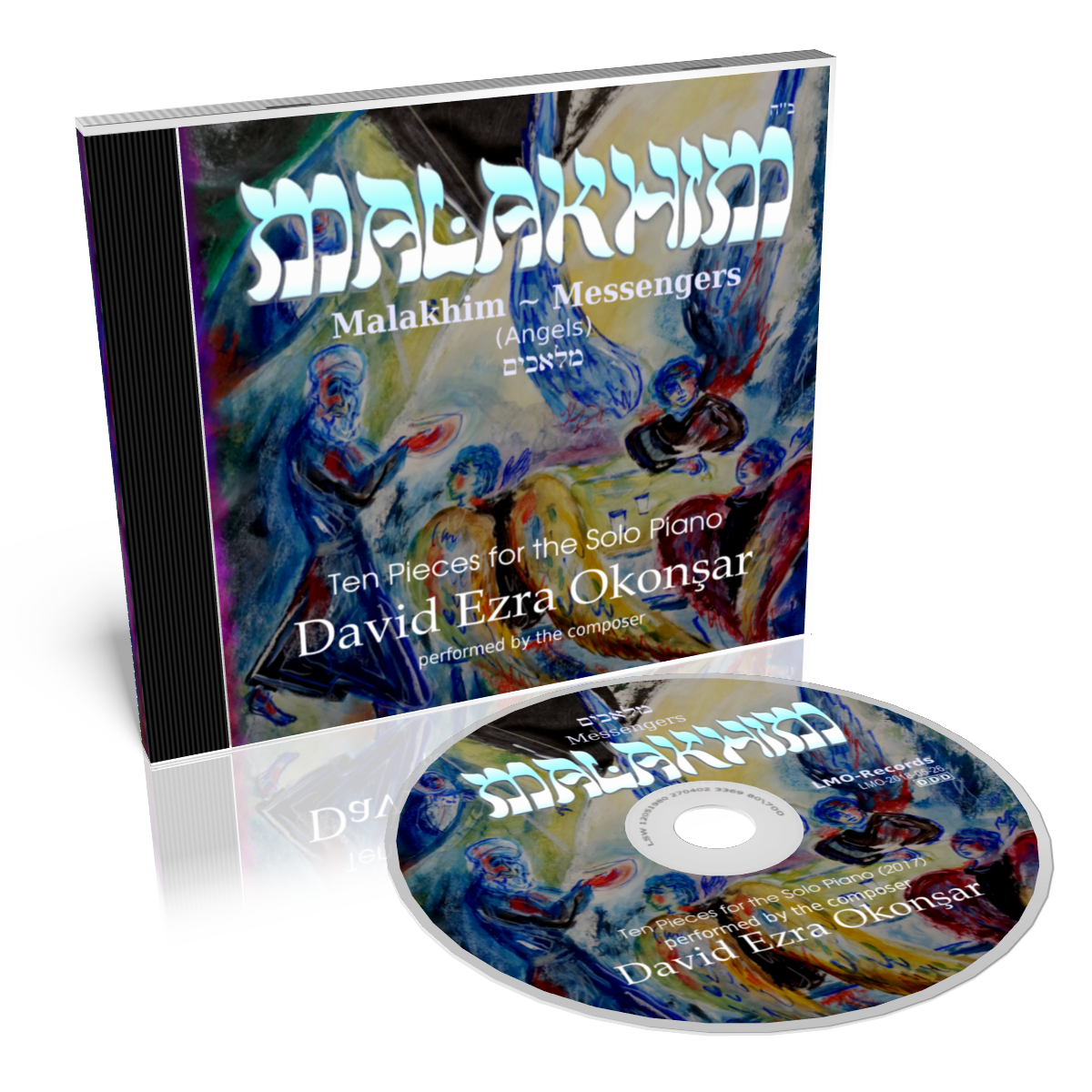(Angels) מלאכים
Ten Pieces For The Solo Piano
the CD
for composition details click here


|
Malakhim (מלאכים, melakhim, malachim), often translated as "angels", literally means messengers. This aspect of the concept constitutes the basic idea for the composition. An angel is a spiritual being and does not have any physical characteristics. The angelic descriptions provided by the prophets - such as wings, arms etc. - are anthropomorphic, referring to their spiritual abilities and tasks. We read first about angels calling out to Abraham, then, angels appearing in Jacob's dream, Jacob fighting with an angel, and angels are then mentioned numerous times throughout the Tanakh. Some angels are created for one specific task, and upon the task's completion cease to exist. According to the Zohar one of the angels' tasks is to transport our words of prayer and Torah-study before G‑d's throne. Another type of angels are those that are created through the deeds of man. These are formed from the intellectual and emotional energy which one invests in the performance of a mitzvah, the study of Torah, or in prayer. [wkp] Those entities are actually devoid of free will and they are "programmed" for one task only. Such as Michael, who is dispatched on missions, which are expressions of G‑d's kindness; Gavriel, who executes G‑d's severe judgments; and Rafael, whose responsibility it is to heal. [chbd] The Malakhim, messengers or angels may be said to be typically "mono-thematic" beings. Therefore, the entire cycle is constructed each piece with one single idea, they are, in a sense "mono-thematic". To musically reflect the idea of an angel as a "limited" and "closed-system" being, each derived from a single source (G.d's power), but somehow independent from it, I made a master tone-series but did not use it as is as the main series of any piece which makes the cycle. Ten derivative series were formed from this main one, one for each particular piece. However, in some pieces, from time to time, the main tone-row appears in its original form. This master series is mainly featuring minor and major thirds, but the perfect four interval which is so characteristic in the symbolism of the Western music as a reference to the "divine harmony", since and even before J. S. Bach to our days, is also noticeably present. Three typical, "leitmotiv" chords, each made of four successive pitches of the main series, do appear in each piece, in various forms. Those chords are: I: [C-E flat-A flat- B] II: [D-F sharp-G-B flat] III: [C sharp-E-F-A]. Two groups of six notes in quick succession is another "leitmotiv", often exposed throughout the pieces: I: [C-E flat- A flat-B-F sharp-D] II: [G-b flat-F-C sharp-E-A]. The continuity of the series of pieces is based on the analogies of each particular tone-row with the main one. The titles and order of the pieces are based on the commonly accepted names and hierarchical order of angels, as established by Moshe bin Maimon (Maimonides a.k.a Rambam, 1135-1204) in his Mishneh Torah. Rabbi Moses ben Maimon, a Jewish philosopher, was one of the most prolific and influential Torah scholars of the Middle Ages. The Mishneh Torah, probably his most important work, is a code of Jewish religious law (Halakha) and it was compiled while Maimonides was living in Egypt, between 1170 and 1180. [wkp] Maimonides counts ten ranks of angels in the Jewish angelic hierarchy, beginning from the highest: Chayot Ha Kodesh; Ophanim; Erelim; Hashmallim; Seraphim; Malakim; Elohim; Bene Elohim; Cherubim; Ishim. This order is respected, but in reverse order, from the lowest to the highest in the cycle. The ten pieces for the piano, inspired by the denominations, hierarchical order (reversed) and commonly given attributes of beings referred to as "angels" (Malakhim, messengers) as described by Maimonides are: I - Ishim: "manlike" beings [Genesis 10-5 and Daniel 10-5] II - Cherubim: "unearthly beings who directly attend to God" [Ezekiel 10-1] III - Bene Elohim: "Sons of Godly beings" [Genesis 6:1-4 and Job: 1:6, Job: 38:7] IV - Elohim: "Godly beings" [Bereshit 1:1] V - Malakim: messengers, angels VI - Seraphim: "the burning one" [Isaiah 6] VII - Hashmallim: "stormy wind coming from the north" [Ezekiel 1:4] VIII - Erelim: "the valiant, courageous" [Isaiah 33:7] IX - Ophanim: "the wheels that never sleep" [Ezekiel 1 and Ezekiel 10] X - Chayot Ha Kodesh: "living beings, angels of fire" [Ezekiel 1 and Ezekiel 10] For details on
angeology in Judaism and in general, please go to: http://www.okonsar.com/012-Compositionpage_Malakhim.html
I - ISHIM ("manlike beings") Ishim is a very strong piece with bursts of dazzling light. Short phrases with incisive rhythms alternate with softer sections with, again short phrases. II - CHERUBIM ("unearthly beings who directly attend to God") A scherzo-like piece, Cherubim is mostly made of fast and unpredicted rhythms. It is jumping swiftly across the keyboard. III - BENE ELOHIM ("Sons of Godly beings") Bene Elohim s a tender piece, mixing some scherzo-like elements with long-breathed and cuddly melodic lines. The staccato lines are varied throughout by using or not using the pedal. Sometimes a scherzo line merges to a melodic one and the boundaries get blurry at will. Worth noting in this piece also the use of the B-Major and F-sharp minor "chords" that I call "entities" for they are being used without reference to the tonal grammar, but as persisting, typical, sound-colors. IV - ELOHIM ("Godly beings") This fourth piece of the series represents the limitless power. Complex lines each loaded with great energy mingle with each other. Soft sections are more hunched up with more "square" rhythms Another "persistent entity" is present here as the notes A-sharp and B which somewhat refer to the persisting sounds of the preceding piece. This piece also feature one of the rare moments where the basic tone-row is displayed without any inference and in a persistent rhythm. The harsh and dry staccato and fortissimo chords section will constitute the basic element which will go to the end. The staccato element will be combined first with legato lines and then remain alone but pianissimo towards the Coda. V - MALAKIM ("messengers, angels") Malakhim has something from each previous piece. It has the bright and strong side of Ishim, the exuberance of Cherubim, the lyricism of Bene Elohim and the power of Elohim combined in various ways. Again in this number the original tone-row appears with a unified pace of quarter notes, however it is combined in counterpoint with a melodic line. VI - SERAPHIM ("the burning one") Meandering, serpentine lines start Seraphim. These lines occur in soft and sinuous passages as well as in sections with strong chords and accents. Conundrum is all over the piece, worth noting is the high pitched staccato, pianissimo notes which will start around the middle and bring the puzzling end. VII - HASHMALLIM ("stormy wind coming from the north") Gleaming amber, Hashmallim starts with a dense melodic section. Brief and light beams appear time to time. Interwoven lines evolve with grace and fluidity. Several elements common to the entire cycle of the piece appear either as fast and light runs or steady, moderately paced parts. VIII - ERELIM ("the valiant, courageous") The most challenging, both to the listener and the performer, piece of the series, Erelim takes the idea of the steady, moderate speed unfolding of the tone-rows previously heard towards the end of Hashmallim and takes this to its apex. Mostly notated with sixteenth notes, the tempo and playing characteristics change markedly throughout the piece. Lines of sixteenth notes usually spread over a very large keyboard span. After first materializing as an accompaniment to the "leitmotiv" chords (see above) of the cycle, these lines exhibit a tendency to flounder on the notes E and E-flat. The central part of the piece displays an alternation of two styles: Molto animato (Tempo I) with equal and "secco" no pedal playing and Meno mosso (Tempo II) with "con licenzia" (with liberties with regard to the rhythm) and with pedal. The uninterrupted pace of sixteenth notes ("moto perpetuum") breaks with short rests in several sections, specially in sections with a slower tempo. The short coda features disjointed notes and chords, pianissimo. IX - OPHANIM ("the wheels that never sleep") "The wheels that never sleep" is symbolized with full-bodied melodic lines in piece number nine: Ophanim. "Mono-rhythmic" passages (sections in one single rhythmic step) abound in this piece. This type of figure, previously heard in Malakhim, Seraphim, Hashmallim and mostly in Erelim, is displayed here very soft and tenderly. Briefly interrupted with delicate appearances of the linear leitmotivs they start again as small bells ringing in the high ranges. X - CHAYOT HA KODESH ("living beings, angels of fire") The beginning of that last piece of the cycle, Chayot Ha Kodesh, may seem similar to the introduction of Hashmallim. However, for the first time in the series, no tone-row but instead a full chromatic scale is used. Mono-rhythm tone row displays are again employed here but in wider pitch ranges. The entire central part and the climax of this piece uses a relentless pace of eight notes. The tempo varies somewhat and those mono-rhythm lines are sometimes interrupted with fast notes leitmotives The composition is
dedicated to the memory of Alexis Weissenberg (1929-2012).
Cover art by Shoshannah Brumbacher Notes: [chbd]: chabad.org, by Baruch S. Davidson [wkp]: en.wikipedia.org
|
||||||||||||||||||||||||||||||||||||||||
| |
||||||||||||||||||||||||||||||||||||||||
| |
||||||||||||||||||||||||||||||||||||||||
|
|
||||||||||||||||||||||||||||||||||||||||
|







